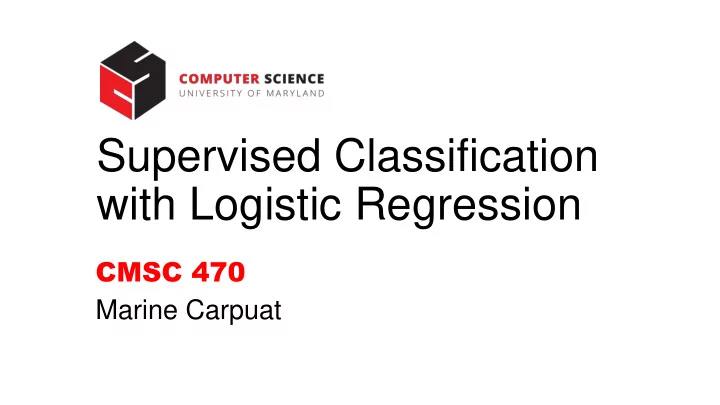

Supervised Classification with Logistic Regression CMSC 470 Marine Carpuat
The Perceptron What you should know • What is the underlying function used to make predictions • Perceptron test algorithm • Perceptron training algorithm • How to improve perceptron training with the averaged perceptron • Fundamental Machine Learning Concepts: • train vs. test data; parameter; hyperparameter; generalization; overfitting; underfitting. • How to define features
Logistic Regression for Binary ry Classification Images and examples: Jurafsky & Martin, SLP 3 Chapter 5
From Perceptron to Probabilities: the Logistic Regression classifier • The perceptron gives us a prediction y, and the activation can take any real value • What if we want a probability p(y|x) instead?
The sigmoid function (aka the logistic function)
From Perceptron to Probabilities for Binary Classification
Making Predictions with the Logistic Regression Classifier • Given a test instance x, predict class 1 if P(y=1|x) > 0.5, and 0 otherwise • Inputs x for which P(y=1|x) = 0.5 constitute the decision boundary
Example: Sentiment Classification with Logistic Regression • 2 classes: 1 (positive sentiment) or 0 (negative sentiment) • Examples are movie reviews • Features:
Constructing the feature vector x for one example
Example: Sentiment Classification with Logistic Regression • Assume we are given the • On this example: parameters of the classifier P(y=1|x) = 0.69 w = P(y=0|x) = 0.31 b = 0.1
Learning in Logistic Regression • How are parameters of the model (w and b) learned? • This is an instance of supervised learning • We have labeled training examples • We want model parameters such that • For training examples x • The prediction of the model ො 𝑧 • is as close as possible to the true y
Learning in Logistic Regression • How are parameters of the model (w and b) learned? • This is an instance of supervised learning • We have labeled training examples • We want model parameters such that • For training examples x, the prediction of the model ො 𝑧 is as close as possible to the true y • Or equivalently so that the distance between ො 𝑧 and y is small
Ingredients required for training • Loss function or cost function • A measure of distance between classifier prediction and true label for a given set of parameters • An algorithm to minimize this loss • Here we’ll introduce stochastic gradient descent
The cross-entropy loss function • Loss function used for logistic regression and often for neural networks • Defined as follows:
Deriving the cross-entropy loss function • Conditional maximum likelihood • Choose parameters that maximize the log probability of true labels y given inputs x • Cross-entropy loss is defined as
Example: Sentiment Classification with Logistic Regression • Assume we are given the • On this example: parameters of the classifier P(y=1|x) = 0.69 w = P(y=0|x) = 0.31 b = 0.1 Loss(w,b) = - log(0.69) = 0.37
Example: Sentiment Classification with Logistic Regression • Assume we are given the • If the example was negative parameters of the classifier (y=0) w = Loss(w,b) = - log(0.31) = 1.17 b = 0.1
Gradient Descent • Goal: • find parameters • Such that • For logistic regression, the loss is convex
Illustrating Gradient Descent The gradient indicates the direction of greatest increase of the cost/loss function. Gradient descent finds parameters (w,b) that decrease the loss by taking a step in the opposite direction of the gradient.
The gradient for logistic regression Feature value for dimension j Difference between the model prediction and the correct answer y Note: the detailed derivation is available in the reading (SLP3 Chapter 5, section 5.8)
Logistic Regression What you should know How to make a prediction with logistic regression classifier How to train a logistic regression classifier Machine learning concepts: Loss function Gradient Descent Algorithm
Recommend
More recommend